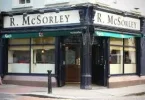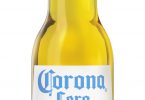Pub food – trends and drivers
The RoI’s 7,200-strong pub foodservice market is estimated to be worth €954 million (or 20% of consumer spend on the entire €7.5bn IoI commercial foodservice channel) and operator purchases (from distributors) run at €277 million according to Bord Bia’s latest Insights report, published in conjunction with international foodservice researchers Technomic.
And Bord Bia estimates a pub food CAGR of 2.3% between 2017 and 2020.
Operational trends
Bord Bia’s Foodservice Specialist Maureen Gahan was the first speaker at this year’s Irish Foodservices Channel Insights seminar at Dublin’s Aviva Stadium.
Her Insights report noted a number of ‘operational’ trends which “have been pivotal in terms of impact on the pub sub-channel in 2016”.
The rising number of tourists this year has helped Ireland’s “well-known bars” in tourist-prone areas and cities to enjoy increased sales, she pointed out.
And the major cities around the country are becoming more saturated with new bars and restaurants, providing multiple concepts under one roof which are increasingly finding success, she stated in the report.
These venues benefit from their ability to attract multiple groups of people looking for different scenes where concepts include cafés, nightclubs and gastro-pubs.
Nevertheless, “Operators are burdened by Ireland’s heavy alcohol tax, increased minimum wage, cost of insurance and increased operating costs,” states the report.
Meanwhile the popularity of craft beer continues to rise. The number of microbreweries in Ireland has more than quadrupled since 2012 to 90, with two-thirds of these producing beer on their own premises and the remainder marketing and selling beer produced by outside breweries. Revenue of €40 million was recorded for 2015 with €59 million projected for 2016. Of the total amount of beer consumed in 2015, 2.5% of it was craft. This is predicted to increase to 3.4% in 2016.
Consumer trends
Unemployment levels are decreasing in Ireland, allowing higher pub-visiting frequencies.
But drinkers today are not as loyal to brands as they were and are exploring new drinks. More pubs are seeing sales increases through broader menus having different types of whiskeys, craft beers and gins.
Consumers continue to look for better quality food offerings at gastro-pubs, being less likely to go for “beverage only occasions”. As a result, food-led pubs have performed very well, encouraging consumers to stay longer and spend more.
These types of establishment create a “blurring of lines” between full-service restaurants (increasingly focused on building a bar business) and pubs.
In discussing expanding the pub’s food and drink menu, Maureen Gahan cited the example of L Mulligan Grocer in Dublin’s Stonybatter as a venue offering a strong food and drink menu which continues to find success. It serves multiple types of whiskey and craft beer as well as serving up local and seasonal ingredients.
For the pub channel in general, current trends necessitate:- considering different menus and drinks for each day-part or as monthly deals; addressing the consumers’ shift towards a food-focused environment and working with local breweries and distilleries to bring new drinks onto the menu.
As one pub operator told the Insights report, “The younger consumers are drinking differently – they start at home and don‘t go to the pub like they used to. More and more competition from other types of operators are also creating challenges.”
Global Consumer trends
David Henkes, Senior Principal with Technomic, followed Maureen to discuss global consumer trends under a number of different catch-phrases:
- Eatertainment reflects consumers wanting a unique experience where they can connect with others over a meal. More money from this type of consumer is going to restaurants, pubs and to dining at home with friends. “Restaurants and pubs are trading on a unique offer that can’t be replicated anywhere else,” he reminded the audience.
- Taking a stand reflects consumers wanting to support brands that align with their own values and that stand for the greater good. He advised telling the consumer where your products come from since much of it involves community ties.
- Big acting small reflects an intensification of the consumer backlash against big brands.
- Now, now, now reflects the new services that are evolving to meet the immediate needs of consumers who expect food on demand.
- Personalisation reflects consumers wanting to be able to tailor their dining experience to their own preferences, a growth area within ‘fast casual’ providing a ‘build your own’ fast food experience.
- Segment blurring reflects the increasing competition from non-traditional sources. David pointed out that in the US, alcohol is a hot Quick Service Restaurant trend exemplified by ‘Starbucks Evenings’ which have now reached London and are likely to be a growth vehicle for the coffee chain going forwards.
So global trends are impacting on Irish foodservice with the competition expanding, he concluded.
The Cash & Carry of the future
Musgrave feeds one in three people in this country and in her presentation Musgrave Marketplace’s Michelle Fennel explained that her understanding of food trends was based on speaking to younger consumers and food experts both here and in the US.
She’d found that ‘Generation Eat’ was more interested in food and way more educated about it, taking more pleasure from food than any generation to date and also looking for healthier options on menus.
But with all the really sophisticated coffee, tea and craft beer offerings, the difficulty was how to separate out the fads from the real trends.
Significance of food to beverage sales
She was followed by Ben Bartley, Operations Manager with the Press Up Entertainment Group which has a number of high-profile outlets in the capital.
Food had become increasingly important to the group, especially since they’d introduced the Wowburger concept to one of the outlets, the Workman’s Club, which had resulted in a 40% increase in early beverage sales. This had been replicated in another of its outlets, The Bison Bar, where the introduction of its large ‘meat smoker’ had witnessed a significant increase in early beverage sales.
Social media too forms a significant part of the marketing mix at Press Up and so the group employs 12 people across three marketing platforms.
UK Eating & Drinking Out Market
Simon Stenning, Executive Director of MCA in the UK, shared some insights on trends happening in the UK foodservice landscape.
He’d listened to the other speakers and warned that technology is an “enabler but not the be-all-and-end-all of hospitality”.
The generation in question wants to eat out – “not drink out” – socially.
“It’s not just about Millennials, but now there’s Generation Z or The ‘I’ Generation,” he said, “These are now coming through to their late teens and early 20s and just entering our marketplace. We must pay more attention to this generation as their behaviour is somewhat different.”
‘Healthier eating’, ‘indulgence’, ‘informality’, ‘premiumisation’, ‘provenance’ and ‘value scrutiny’ rank among the ‘megatrends’ in the UK marketplace today – and Simon agreed that trends can be unsustained or short-lived.
UK pub scene
Since 2007 UK pubs have completely lost their ‘Mojo’ at a rate of 1,000 pubs per year, he claimed.
“They simply forgot what they were about and did not keep up.”
Today’s generation wants to use pubs for something completely different.
“Some pubs there are now re-inventing their Mojos via lounges that you’d find at home, designed to be as cosy as your front room, thus providing a good environment with a product offer to meet this generation’s needs,” he said.
The result has been a growth in the UK pub industry despite a decline in the number of pubs, with the average rate of sale improving.
“Pubs are re-inventing themselves and reclaiming the ‘third space’ that the coffee shops have stolen. That’s where the pubs should have been all along but they didn’t keep up,” he told the seminar, “Now pubs are fighting back, giving great competition and so coffee shops are now looking at alcohol.”








